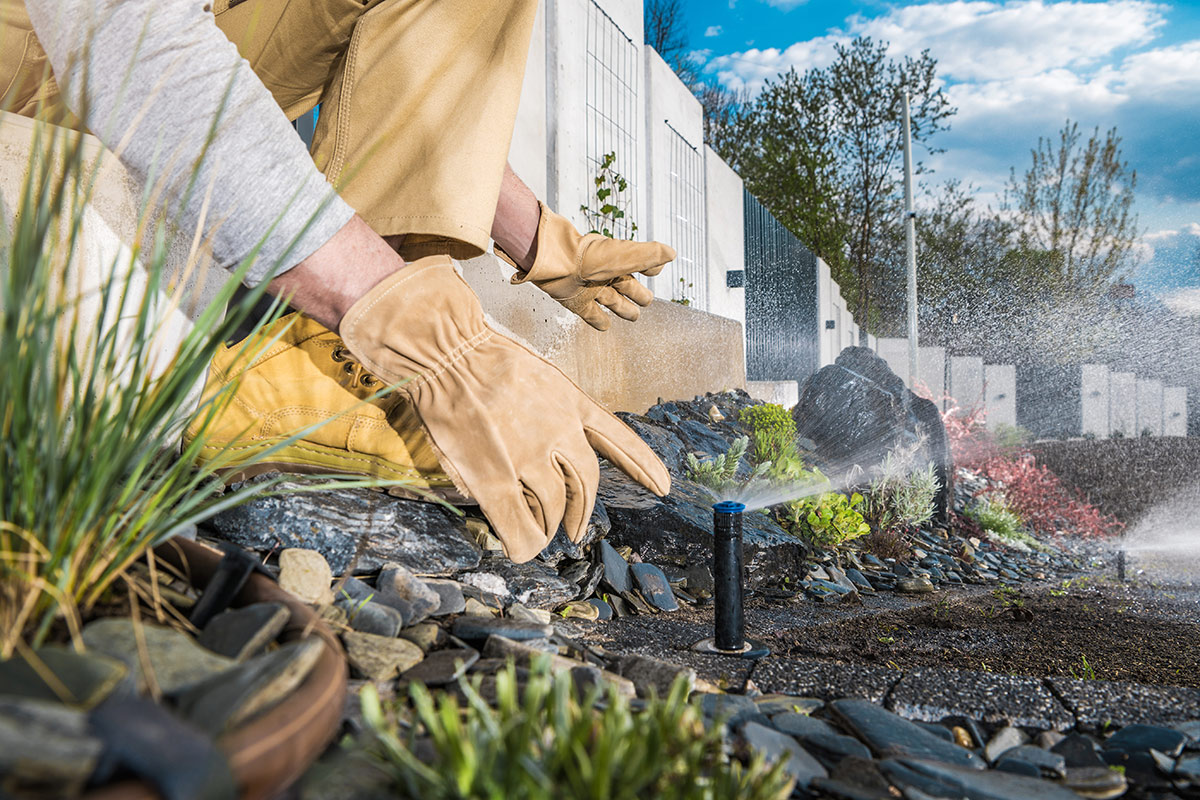Water Management
Request Service
"*" indicates required fields
Water Management Services
For effective water management, it is essential to choose the appropriate irrigation system, utilize technology for optimal water usage, select native plants, and promptly repair any faults in the irrigation system.
We understand soil composition and what existing plants need to thrive. This includes watering frequency, how much is applied, and at what rate to ensure proper absorption and avoid runoff.
Our Water Management team will ensure the efficient operation of your irrigation system and help find rebates through your water agency.
At Sperber Landscape Services, it is important to us to deliver water efficiently and effectively to your landscape.
- Irrigation inspection
- Specializing in irrigation systems and installation
- Irrigation system repairs
- Eco-friendly solutions
- Water management services
- Sprinkler and drip inspections
- Water landscape features
- Customized irrigation services
- Licensed and Certified
- Experts in tech-driven solutions
Irrigation Service
As irrigation specialists, we excel in designing, installing, and maintaining water systems tailored to your landscape’s unique needs. Custom plans prevent waste, sustain plant health, and enhance aesthetics while conserving water. Our expertise identifies and fixes leaks, while meeting your property’s specific requirements through certified, sustainable solutions. Proper irrigation cares for your investment by preventing runoff and hazards. We deliver healthy, efficient, responsible water management.


Technology
We leverage the latest and greatest technology to provide the most efficient watering for your landscape needs. “Smart” irrigation controllers and sensors use weather and soil moisture data to automatically adjust watering schedules, helping to determine water needs and preserve your landscape. Weather-based applications can also modify run times based on local weather forecasts and conditions to avoid overwatering.
Erosion Control and environmental restoration
We specialize in erosion control and environmental restoration. Our team provides personalized solutions to minimize harmful impacts and restore natural ecosystems. Let us help safeguard your land, repair damaged habitats, and preserve your surroundings. When it comes to managing stormwater runoff and preventing pollution, our experts excel at crafting customized Storm Water Pollution Prevention (SWPP) plans that keep your project compliant and your site environmentally sound.


Certified Water Managers
Our IA Certified water managers utilize the latest, most efficient irrigation techniques tailored to your landscape’s specific needs. Proper management ensures your landscape stays healthy while conserving precious water, especially during shortages. Certification validates expertise that protects your investment through sustainable solutions. Choosing certified experts promotes responsibility and guards California’s water future.
CUSTOMized Irrigation Solutions
We are experts in creating efficient custom solutions that evaluate your system, needs, and goals. With the right equipment, like nozzles, regulators, and flow meters, we ensure proper irrigation techniques that promote healthier, weather-tolerant landscapes and deeper root growth.


Drought tolerant landscaping
Efficient water use includes using drought-tolerant plants and turf, which impacts water usage. With California being a drought-prone state, it is essential to select plants and turf native to the area, which not only help with water management but also enhance your landscape.
Most Popular Questions
Our irrigation service helps you choose the best system or evaluate your existing one for efficiency.
Our service typically involves an initial consultation with you to understand specific requirements and preferences. From there, our irrigation experts will conduct a site analysis to determine the best irrigation system that will maximize water efficiency while meeting the landscape’s irrigation needs.
Our process will consider the type of soil, plants, and other landscaping elements to ensure that the irrigation system is tailored to the unique needs of the property. The irrigation system may include drip irrigation, sprinkler systems, and smart irrigation controllers that can adjust watering schedules based on weather forecasts and soil moisture levels.
Overall, the service aims to create a sustainable and efficient irrigation system that will help save water, reduce water bills, and maintain healthy and vibrant landscaping.
The following plants are drought-resistant and suitable for Southern California:
– Lavender
– Succulents
– California poppies
– and Agave.
Plants like these require minimal watering and can thrive in hot and dry weather.
Conserving water is essential, and there are different irrigation systems available that are both efficient and practical. Two popular options are drip irrigation, which delivers water directly to the roots of plants through a network of tubes, and soaker hoses, which release water slowly and evenly along the length of the hose.
A smart irrigation system is worth considering as it uses sensors and weather data to adjust watering schedules for your plants’ specific needs. You can also collect rainwater in barrels or cisterns and use it to water your plants.
Other irrigation systems include center pivot irrigation, subsurface irrigation, and flood irrigation. Each system has its own advantages and disadvantages, so it’s essential to choose the one that suits your particular needs.
“Smart” irrigation technology based on weather utilizes live weather data to calculate the precise timing and quantity of water required for plants.
By taking into account factors like temperature, humidity, and precipitation, these systems can optimize watering schedules and reduce waste. This technology helps to conserve water and decrease energy expenses while promoting the growth of healthier plants and lawns.
Storm Water Pollution Prevention Plans (SWPPPs) are site-specific plans required under the California Construction General Permit for construction projects that disturb 1 acre or more of land. They outline the measures and best management practices (BMPs) that will be implemented at the construction site to prevent soil erosion and discharge of sediments and other construction-related pollutants that could contaminate nearby waterways during storm events.
SWPPPs identify possible pollutant sources at the site and contain site maps showing drainage patterns, nearby waterbodies, stormwater collection points, and proposed BMP locations. They specify control practices such as silt fencing, storm drain inlet protection, soil stabilization methods, concrete washout areas, and construction entrances to minimize tracking of sediment. SWPPPs also provide maintenance and inspection schedules for BMPs and include training plans and record-keeping requirements.
By preventing erosion and keeping stormwater runoff clean, SWPPPs are an important tool for protecting water quality in California during the construction process. They ensure compliance with clean water laws and prevent environmental fines, making them a necessity for larger renovation projects. Engaging qualified SWPPP developers is key to creating an effective plan tailored to your project site.
A water audit is a comprehensive evaluation of a property’s water usage to identify opportunities for water conservation and efficiency improvement.
The audit process involves analyzing water usage and conducting an on-site inspection to identify leaks, inefficient systems, and other areas where water can be saved.
The primary objective of a water audit is to reduce water usage, save money on water bills, and preserve this valuable natural resource, all while maintaining and caring for a beautiful landscape.
To ensure your existing irrigation system operates at peak efficiency, there are several things you can do:
1. Check for leaks: Leaks can significantly reduce the efficiency of your irrigation system. Make sure to check for leaks in the pipes, valves, sprinkler heads, and connections. Repair any leaks as soon as possible.
2. Adjust sprinkler heads: Make sure the sprinkler heads are properly adjusted to avoid watering non-target areas like sidewalks and driveways. Properly adjusted sprinkler heads will also help to avoid over-watering and under-watering and deliver the water where it needs to go.
3. Schedule watering times: Watering during the early morning hours when temperatures are cooler can help reduce water loss due to evaporation. It is also important to not water too frequently, as this can lead to water waste.
4. Upgrade the system: Consider upgrading your irrigation system with smart technologies such as weather-based controllers and soil moisture sensors. These devices can help to optimize watering by adjusting the schedule and duration of watering based on the weather and soil moisture levels.
By following these tips, you can ensure that your irrigation system operates at peak efficiency, which will save water and money in the long run.
Here are ten tips that can help you save both money and water through landscape conservation:
1. Choose native plants that are well-suited to your region’s climate and soil type. They will require less water and maintenance than non-native species.
2. Group plants with similar water needs together, so you can water them efficiently without wasting water on plants that don’t need it.
3. Install drip irrigation or soaker hoses, which are more efficient than sprinklers and can reduce water waste.
4. Use mulch around plants to reduce evaporation and keep the soil moist, reducing the need for watering.
5. Water your plants in the early morning or late evening when the temperature is cooler to reduce evaporation and ensure the plants absorb the water.
6. Collect rainwater in a barrel or other container and use to water your plants.
7. Use a broom or blower to clean outdoor areas instead of hosing them down.
8. Install a rain sensor on your irrigation system to prevent it from watering during or immediately after rain.
9. Use a hose nozzle with an automatic shut-off feature to avoid wasting water while watering your plants.
10. Test the spray patterns of your sprinkler heads to avoid overspray and to ensure uniform distribution where the water is needed.
Using drought-tolerant or native plants in your landscape can offer many benefits. Here are five reasons why you should consider using them:
1. Water Conservation. Drought-tolerant plants require significantly less water than traditional plants, which is especially important in areas with low rainfall or water restrictions.
2. Low Maintenance. Native plants are well adapted to the local environment and require less maintenance than non-native plants. They are also more resistant to pests and diseases, reducing the need for pesticides and other chemicals.
3. Cost Savings. Because they require less water and maintenance, drought-tolerant and native plants can save you money on your water bill and landscaping expenses.
4. Wildlife Habitat. Native plants provide food and shelter for birds, butterflies, bees, and other wildlife, helping to support local ecosystems.
Aesthetics. Drought-tolerant and native plants are available in a wide variety of colors, textures, and sizes, and can be used to create beautiful and unique landscapes that are well-adapted to the local environment.
Areas of Expertise
Residential
HOAs, Master Planned Communities, Multi-Family Residential, Military House
Office
Commercial offices, Corporate Campuses, Industrial Facilities, Creative Office Spaces
Medical
Hospitals, Medical Centers, Rehabilitation, MOBs, Acute Care Centers
Education
Colleges, Universities, K-12 Schools
RecreatIon
Parks and Civic Spaces, Golf Courses, Museums, Theme Parks Complexes and Fields
Retail
Retail and Lifestyle Centers, Shopping Malls, Mixed Use Developments
Hospitality
Hotels, Destination Resorts, Country Clubs, Theme Parks
religion
Places of Worship, Cemeteries
SPEAK WITH AN EXPERT
"*" indicates required fields
